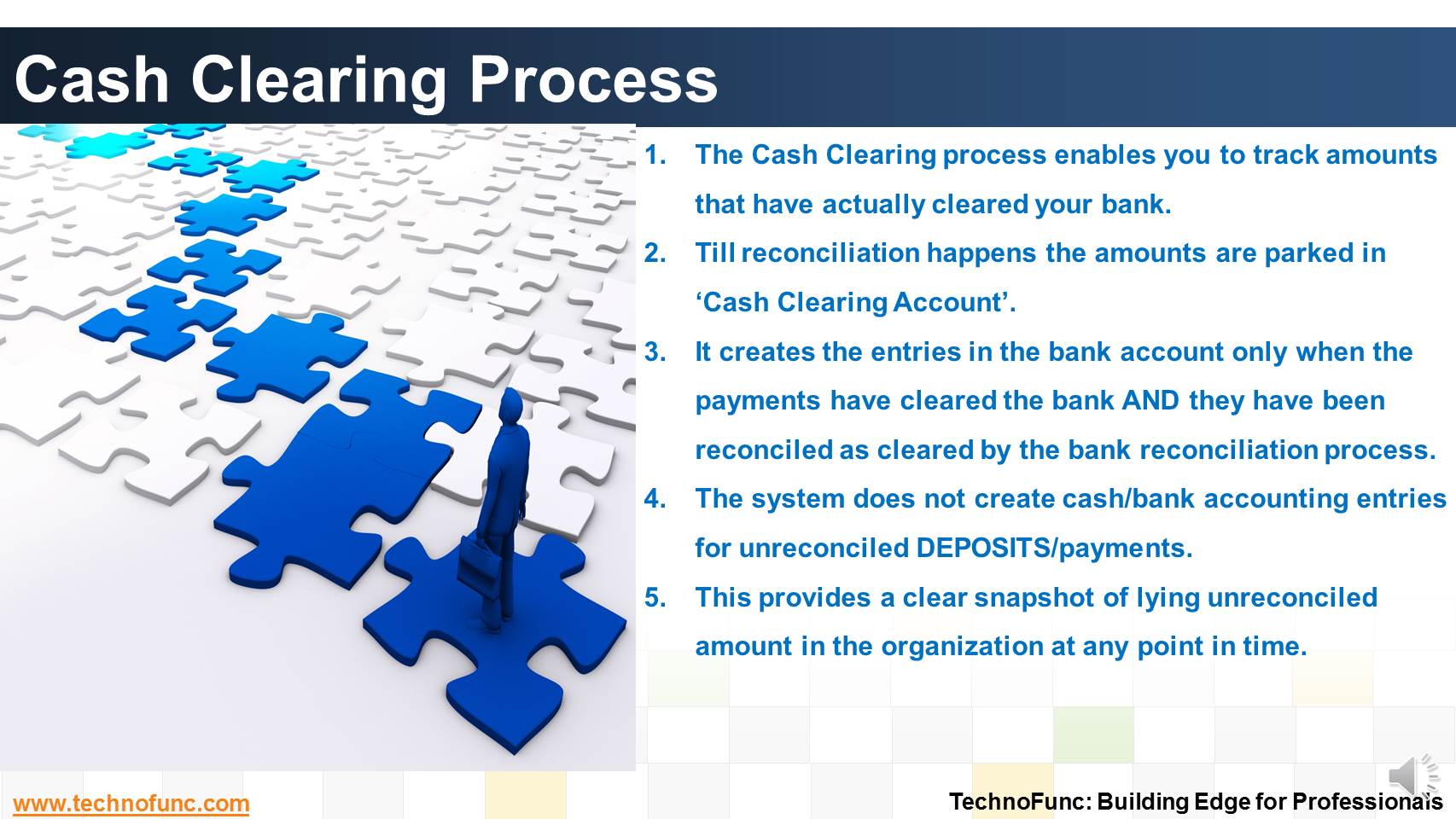- Home
- Business Processes
- Industry Knowledge
- Aerospace Industry
- Automotive Industry
- Banking Domain
- BFSI Industry
- Consumer/ FMCG Industry
- Chemicals Industry
- Engineering & Construction
- Energy Industry
- Education Domain
- Finance Domain
- Hospitality Domain
- Healthcare Industry
- Insurance Domain
- Retail Industry
- Travel and Tourism Domain
- Telecom Industry
- Leadership Skills
- eLearning
- Home
- Functional
- Cash Management
- Cash Clearing Process
Cash Clearing Process
The Cash Clearing process enables you to track amounts that have actually cleared your bank. Till reconciliation happens the amounts are parked in 'Cash Clearing Account'.
Cash Clearing Process
Rather than hitting the bank accounts, in cash clearing systems, the cash/bank transactions are parked in 'Cash Clearing Account'.
Once reconciliation with bank statement is done the reconciled amount is transferred to Cash/Bank Account.
This provides a clear snapshot of lying unreconciled amount in the organization at any point in time.
The Cash/Bank account reflects only the balance that has been reconciled with the transactions of Bank.
The Cash Clearing process enables you to track amounts that have actually cleared your bank versus amounts still floating in the banking system.
The Cash Clearing process creates accounting entries to record the actual settlement in your cash/bank account in general ledger only when you clear the payment transactions in the system during the reconciliation process.
Till reconciliation happens the amounts are parked in 'Cash Clearing Account'.
It creates the entries in the bank account only when the payments have cleared the bank AND they have been reconciled as cleared by the bank reconciliation process.
The system does not create cash/bank accounting entries for unreconciled DEPOSITS/payments.
This provides a clear snapshot of lying unreconciled amount in the organization at any point in time.

Related Links
You May Also Like
-
In the previous article we talked about the meaning of the account reconciliations. Now as you now the definition of account reconciliation, in this article let us see why it is carried out.
-
Disbursement Float is the time taken from payment creation to settlement. Collection float is the sum total of time taken by Payment Float; Mail Float; Processing Float and Availability Float. Learn more!
-
Collection Float is the time spent to collect receivables. Collection float is the sum total of time taken by Invoice Float; Mail Float; Processing Float and Availability Float. Explore more!
-
Treasury has increasingly become a strategic business partner across all areas of the business, adding value to the operating divisions of the company. Managing activities that were traditionally carried out within the general finance function. Learn about the drivers for this change.
-
In automated clearing, Bank statement details are automatically matched and reconciled with system transactions. Learn how this process works and what are the perquisites to enable the same.
-
Suspense and clearing accounts resemble each other in many respects but there exists important fundamental difference between the two. Read more to explore these differences.
-
So many codes in the lines that are there in a Bank Statement. It contain lots and lots of meaningful information that can help automated many tasks. Explore more!
-
The objective of Financial risk management is to protect assets and cash flows from any risk. Treasury function works to accurately assess financial risks by identifying financial exposures including foreign exchange, interest rate, credit, commodity and other enterprise risks. Learn about the various risks that are managed by treasury.
-
Many different accounts are used in finance. Understand the representation and nature of clearing account in context of accounting, finance and ERP Systems.
-
What are the various sources of cash in an organization. Which sources increase the cash available with the enterprise and which sources results in outflow of the cash? Let us explore!
Explore Our Free Training Articles or
Sign Up to Start With Our eLearning Courses

About Us
Learning
© 2023 TechnoFunc, All Rights Reserved










